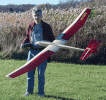|
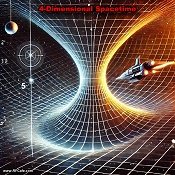 When I read this account of relativistic
space travel by Dr. Wernher von Braun in a 1963 issue of Popular Science
magazine, I was a bit dubious about numbers he presented because they seemed to
me to assume a fixed value of relativistic speed during the entire round trip.
It is an example of the
Twin Paradox. Time dilation, as predicted by Einstein's theory of Special
Relativity, is barely noticeable at 10% the speed of light (0.1c), and is not
really significantly noticeable until around 30% the speed of light (0.3c), so I
suspected that maybe he had simplified the answer. His space ship example
reached that speed at 3½ months with a steady 1 G acceleration rate. Not wanting
to go to the effort of figuring it out for myself, I asked ChatGPT 4.0 to assess
the article and render an opinion... When I read this account of relativistic
space travel by Dr. Wernher von Braun in a 1963 issue of Popular Science
magazine, I was a bit dubious about numbers he presented because they seemed to
me to assume a fixed value of relativistic speed during the entire round trip.
It is an example of the
Twin Paradox. Time dilation, as predicted by Einstein's theory of Special
Relativity, is barely noticeable at 10% the speed of light (0.1c), and is not
really significantly noticeable until around 30% the speed of light (0.3c), so I
suspected that maybe he had simplified the answer. His space ship example
reached that speed at 3½ months with a steady 1 G acceleration rate. Not wanting
to go to the effort of figuring it out for myself, I asked ChatGPT 4.0 to assess
the article and render an opinion...
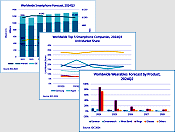 Here are eight
predictions for the semiconductor industry in 2025, per the IDC
(International Data Corporation). "1: Memory is expected to grow by more than
24%, mainly driven by the increasing penetration of high-end products such as
HBM3 and HBM3e with HBM4 expected to be introduced in H2. Non-memory is expected
to grow 13%, driven by demand for advanced node ICs for AI servers, high-end
mobile phone ICs, and WiFi7. 2: Asia-Pacific IC design market will grow 15% as
inventory levels stabilize, personal devices demand picks up, and AI computing
extends to a wide range of applications. 3: Under the traditional Foundry 1.0
definition..." Here are eight
predictions for the semiconductor industry in 2025, per the IDC
(International Data Corporation). "1: Memory is expected to grow by more than
24%, mainly driven by the increasing penetration of high-end products such as
HBM3 and HBM3e with HBM4 expected to be introduced in H2. Non-memory is expected
to grow 13%, driven by demand for advanced node ICs for AI servers, high-end
mobile phone ICs, and WiFi7. 2: Asia-Pacific IC design market will grow 15% as
inventory levels stabilize, personal devices demand picks up, and AI computing
extends to a wide range of applications. 3: Under the traditional Foundry 1.0
definition..."
 A mere five years elapsed from the time Echo,
a gas-filled metallized plastic sphere that passively reflected radio signals back
to Earth, was launched and the time that 35
television cameras had been launched into space. The Space Race
was at a fever pitch. Although the Ruskies beat us in being the first to launch
both an active satellite (Sputnik) and a man
(Yuri Gagarin) into space, America's deep pool of
intellectual resources, consisting of both native scientists and many of the world's
top scientists who chose to flourish in freedom here rather than oppression behind
the Iron Curtain, fostered the advantage that in short order established the United
States as the leading super power both in space and on terra firma. TIROS
satellites began providing real-time visual data on the Earth's weather in 1960.
Not only were cameras transmitting images of the Earth... A mere five years elapsed from the time Echo,
a gas-filled metallized plastic sphere that passively reflected radio signals back
to Earth, was launched and the time that 35
television cameras had been launched into space. The Space Race
was at a fever pitch. Although the Ruskies beat us in being the first to launch
both an active satellite (Sputnik) and a man
(Yuri Gagarin) into space, America's deep pool of
intellectual resources, consisting of both native scientists and many of the world's
top scientists who chose to flourish in freedom here rather than oppression behind
the Iron Curtain, fostered the advantage that in short order established the United
States as the leading super power both in space and on terra firma. TIROS
satellites began providing real-time visual data on the Earth's weather in 1960.
Not only were cameras transmitting images of the Earth...
 An RF Cafe visitor sent this equation to
me a few years ago. It can be found all over the Internet (including here), but
I cannot determine a definite origin. Mathematicians claim that math can explain
everything in the universe, which is not quite true. It can't for example, explain
why my next-door neighbor is a junk hoarder. This
Christmas equation
does not appear to begin with a particular application; it looks like something
from a set of textbook end-of-chapter problems. Even if you don't celebrate Christmas,
it provides a secondary benefit by demonstrating rules for the manipulation of logarithms
and exponents along with basic algebraic rearrangements of terms... An RF Cafe visitor sent this equation to
me a few years ago. It can be found all over the Internet (including here), but
I cannot determine a definite origin. Mathematicians claim that math can explain
everything in the universe, which is not quite true. It can't for example, explain
why my next-door neighbor is a junk hoarder. This
Christmas equation
does not appear to begin with a particular application; it looks like something
from a set of textbook end-of-chapter problems. Even if you don't celebrate Christmas,
it provides a secondary benefit by demonstrating rules for the manipulation of logarithms
and exponents along with basic algebraic rearrangements of terms...
 Merriam-Webster defines
Christmastide as "the festival season from Christmas Eve till
after New Year's Day or especially in England till Epiphany." In 1930 when this
article appeared in Radio-Craft magazine, most likely everyone knew what
Christmastide was, but not so much today. While reading and scanning vintage magazine
articles throughout the year, I set aside ones specific to holidays like Christmas,
Thanksgiving, Halloween, etc., and post them during their respective seasons. This
story is about the trouble caused by a well-meaning but unqualified family member
attempting to fix a radio that wasn't broken by gifting dear old Dad a Balkite trickle
charger (radiomuseum.org has one) for his battery-powered radio set. It also mentions
using a potato to test the DC polarity of a power supply or battery... Merriam-Webster defines
Christmastide as "the festival season from Christmas Eve till
after New Year's Day or especially in England till Epiphany." In 1930 when this
article appeared in Radio-Craft magazine, most likely everyone knew what
Christmastide was, but not so much today. While reading and scanning vintage magazine
articles throughout the year, I set aside ones specific to holidays like Christmas,
Thanksgiving, Halloween, etc., and post them during their respective seasons. This
story is about the trouble caused by a well-meaning but unqualified family member
attempting to fix a radio that wasn't broken by gifting dear old Dad a Balkite trickle
charger (radiomuseum.org has one) for his battery-powered radio set. It also mentions
using a potato to test the DC polarity of a power supply or battery...
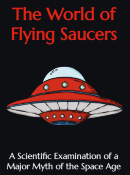 Here is a very timely article entitled,
"Flying
Saucers - Myth or Fact?," which appeared in a 1964 issue of Radio-Electronics
magazine. The recent rash of unidentified flying objects over parts of New Jersey,
Wright-Patterson AFB, and a few other key locations has resurrected an interest
in whether "UFOs" exist. Despite hundreds of reports of what appear to be large
drones, the government insists they are not U.S. or foreign military equipment.
They specifically do not deny that they belong to some U.S. government agency -
like Homeland Security, FBI, CIA, etc. Conjecture that they are "nuke-sniffing"
drones searching for missing fissionable material. Regarding UFO video recordings,
have you noticed how with all the high tech cameras out there that there has never
been a clear, up-close picture of one? Those glimmering "orbs" in videos is clearly
the planet Venus in the evening sky right now... Here is a very timely article entitled,
"Flying
Saucers - Myth or Fact?," which appeared in a 1964 issue of Radio-Electronics
magazine. The recent rash of unidentified flying objects over parts of New Jersey,
Wright-Patterson AFB, and a few other key locations has resurrected an interest
in whether "UFOs" exist. Despite hundreds of reports of what appear to be large
drones, the government insists they are not U.S. or foreign military equipment.
They specifically do not deny that they belong to some U.S. government agency -
like Homeland Security, FBI, CIA, etc. Conjecture that they are "nuke-sniffing"
drones searching for missing fissionable material. Regarding UFO video recordings,
have you noticed how with all the high tech cameras out there that there has never
been a clear, up-close picture of one? Those glimmering "orbs" in videos is clearly
the planet Venus in the evening sky right now...
 Salaries trend up for electrical and electronics
engineers in 2024 per this Electronic Design magazine survey
-- mine has been going down for years :{ "In
a tight labor market, skilled engineers continue to have leverage when negotiating
salaries and pushing for bonuses and other perks. In 2024, the median income of
electronics engineers and other tech professionals who responded to the survey is
in the range of $125,000 to $149,999. The survey revealed that slightly more than
20% of engineers expect to earn between $150,000 and $199,999, excluding bonuses,
overtime pay, and other earnings over and above their base salary... Salaries trend up for electrical and electronics
engineers in 2024 per this Electronic Design magazine survey
-- mine has been going down for years :{ "In
a tight labor market, skilled engineers continue to have leverage when negotiating
salaries and pushing for bonuses and other perks. In 2024, the median income of
electronics engineers and other tech professionals who responded to the survey is
in the range of $125,000 to $149,999. The survey revealed that slightly more than
20% of engineers expect to earn between $150,000 and $199,999, excluding bonuses,
overtime pay, and other earnings over and above their base salary...
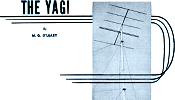 The
Yagi–Uda antenna,, often referred to simply as the Yagi antenna, was developed
in the late 1920s by Japanese engineers Hidetsugu Yagi and Shintaro Uda at Tohoku
University in Sendai, Japan. The primary motivation for their work was to design
a highly directional antenna capable of efficiently transmitting and receiving radio
waves over specific frequencies. This need arose as radio communications technology
was rapidly advancing, with an emphasis on improving signal strength and selectivity
for applications in research and burgeoning communication systems. Mssrs. Yagi
and Uda sought to enhance the performance of basic dipole antennas by creating an
array that exhibited improved directivity and gain. .. The
Yagi–Uda antenna,, often referred to simply as the Yagi antenna, was developed
in the late 1920s by Japanese engineers Hidetsugu Yagi and Shintaro Uda at Tohoku
University in Sendai, Japan. The primary motivation for their work was to design
a highly directional antenna capable of efficiently transmitting and receiving radio
waves over specific frequencies. This need arose as radio communications technology
was rapidly advancing, with an emphasis on improving signal strength and selectivity
for applications in research and burgeoning communication systems. Mssrs. Yagi
and Uda sought to enhance the performance of basic dipole antennas by creating an
array that exhibited improved directivity and gain. ..
 Margaret LeFevre created a handful
electronics-themed crossword puzzles for the July 1961 issue of
Electronics World magazine. Crosswords have been around for at least two
centuries and come in many formats from having both x- and y-axis symmetry to symmetry
about only one axis or even no symmetry at all. They can be square, rectangular,
or have special shapes. This particular one has partial symmetry about the y-axis.
Note that it is composed of two isolated regions with no open path between the regions.
If you enjoy working crossword puzzles, there are plenty more which I have posted
from electronics magazines, plus I have... Margaret LeFevre created a handful
electronics-themed crossword puzzles for the July 1961 issue of
Electronics World magazine. Crosswords have been around for at least two
centuries and come in many formats from having both x- and y-axis symmetry to symmetry
about only one axis or even no symmetry at all. They can be square, rectangular,
or have special shapes. This particular one has partial symmetry about the y-axis.
Note that it is composed of two isolated regions with no open path between the regions.
If you enjoy working crossword puzzles, there are plenty more which I have posted
from electronics magazines, plus I have...
• Kids Can
Talk to Santa via Ham Radio
•
Cellphone Radiation Linked to Brain Cancer
• EU Gives
€127M
Funding Boost to 6G Research
• Q3 Foundry
Revenues up 27% Y-o-Y
•
TSMC Panics When Identified Huawei Chip Maker
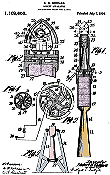 By the time editor Hugo Gernsback wrote
his "Electronic
Failures in Space" article for the April 1964 issue of Radio-Electronics
magazine, half a decade had passed since the official end of the International Geophysical
Year (which was actually 18 months long). Much new knowledge had been gained and
theories confirmed regarding the environment electronics would be exposed to not
just while above the atmosphere, but also while passing through it. Oh, and the
extreme vibration and acceleration during the launch and boost phases to get into
space were no piece of cake to accommodate, either. Fortunately, a lot of immensely
smart and dedicated people worked out the bugs one by one, and we have arrived at
a vastly advanced... By the time editor Hugo Gernsback wrote
his "Electronic
Failures in Space" article for the April 1964 issue of Radio-Electronics
magazine, half a decade had passed since the official end of the International Geophysical
Year (which was actually 18 months long). Much new knowledge had been gained and
theories confirmed regarding the environment electronics would be exposed to not
just while above the atmosphere, but also while passing through it. Oh, and the
extreme vibration and acceleration during the launch and boost phases to get into
space were no piece of cake to accommodate, either. Fortunately, a lot of immensely
smart and dedicated people worked out the bugs one by one, and we have arrived at
a vastly advanced...
 "Arizona State University (ASU) in the USA
reports on high-voltage aluminum nitride (AlN) metal–semiconductor field-effect
transistors (MESFETs)
on single-crystal AlN substrates. The researchers claim their work as the first
report of 'AlN transistors via homoepitaxial growth on native substrates.' The team
comments: 'The devices showed good saturation and pinch-off behavior with high maximum
Ids, gm and on/off ratio compared with AlN-on-sapphire devices without complicated
contact layers.' AlN has the highest breakdown electric field, 12MV/cm..." "Arizona State University (ASU) in the USA
reports on high-voltage aluminum nitride (AlN) metal–semiconductor field-effect
transistors (MESFETs)
on single-crystal AlN substrates. The researchers claim their work as the first
report of 'AlN transistors via homoepitaxial growth on native substrates.' The team
comments: 'The devices showed good saturation and pinch-off behavior with high maximum
Ids, gm and on/off ratio compared with AlN-on-sapphire devices without complicated
contact layers.' AlN has the highest breakdown electric field, 12MV/cm..."
 The history of growing
semiconductor boules is a cornerstone of modern electronics, marking advancements
in material science and technology that have propelled numerous industries. Boule
growth processes have their roots in the early 20th century, when researchers first
sought to create pure semiconductor materials for experimental purposes. Initially,
materials such as germanium (Ge) and silicon (Si) were used, with silicon ultimately
becoming the most prevalent due to its superior properties and availability. Germanium
was the first material used extensively in semiconductor applications, as its electronic
properties made it suitable for early transistor designs. The Czochralski process,
developed in 1916, was adapted for germanium and later silicon. This method, involving
the slow pulling of a seed crystal from molten material, remains fundamental to
boule growth today. Silicon's dominance... The history of growing
semiconductor boules is a cornerstone of modern electronics, marking advancements
in material science and technology that have propelled numerous industries. Boule
growth processes have their roots in the early 20th century, when researchers first
sought to create pure semiconductor materials for experimental purposes. Initially,
materials such as germanium (Ge) and silicon (Si) were used, with silicon ultimately
becoming the most prevalent due to its superior properties and availability. Germanium
was the first material used extensively in semiconductor applications, as its electronic
properties made it suitable for early transistor designs. The Czochralski process,
developed in 1916, was adapted for germanium and later silicon. This method, involving
the slow pulling of a seed crystal from molten material, remains fundamental to
boule growth today. Silicon's dominance...
 Side-looking airborne radar (SLAR) started
out using a narrow beam formed by reflectors, like traditional radars, as opposed
to the synthetic aperture type most often used today. Both types of side-looking
radars rely primarily on the physical movement of the airborne platform for effective
azimuthal scanning rather than steering the beam either mechanically or electronically.
This 1965 Electronics World magazine article represents early versions
which used "real aperture" antennas. Modern computer-controlled synthetic aperture
radar beams can be segmented and directed off-axis for detected... Side-looking airborne radar (SLAR) started
out using a narrow beam formed by reflectors, like traditional radars, as opposed
to the synthetic aperture type most often used today. Both types of side-looking
radars rely primarily on the physical movement of the airborne platform for effective
azimuthal scanning rather than steering the beam either mechanically or electronically.
This 1965 Electronics World magazine article represents early versions
which used "real aperture" antennas. Modern computer-controlled synthetic aperture
radar beams can be segmented and directed off-axis for detected...
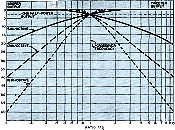 Did I ever bore you with my experience building
a crossover network for a set of medium power speakers (about 100 watts each) when
in the USAF? Too bad I didn't have this "How
to Build a Crossover Network" article from a 1968 issue of Radio-Electronics
magazine handy. I'll spare you the details, but the era was 1979, and I was in tech
school at Keesler AFB studying to be an Air Traffic Control Radar Repairman. Being
amped up (pun intended) with electronics theory with both semiconductor and vacuum
tube circuits, I was looking to cobble together a nice amplifier and a set of speakers.
Back in the day, it was possible to buy the components... Did I ever bore you with my experience building
a crossover network for a set of medium power speakers (about 100 watts each) when
in the USAF? Too bad I didn't have this "How
to Build a Crossover Network" article from a 1968 issue of Radio-Electronics
magazine handy. I'll spare you the details, but the era was 1979, and I was in tech
school at Keesler AFB studying to be an Air Traffic Control Radar Repairman. Being
amped up (pun intended) with electronics theory with both semiconductor and vacuum
tube circuits, I was looking to cobble together a nice amplifier and a set of speakers.
Back in the day, it was possible to buy the components...
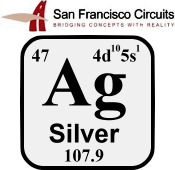 San Francisco Circuits, a premier provider
of leading edge technology printed circuit boards, has published a new article on
the
Immersion Silver Surface Finish process, also known as immersion Ag. It is an
RoHS compliant (lead-free) PCB surface finish offering exceptional flatness and
cost efficiency. This surface finish is particularly well-suited for fine-pitch
components and can replace Immersion Gold over Electroless Nickel (ENIG) in many
applications. Unlike ENIG, Immersion Silver applies directly to copper without requiring
a diffusion barrier. It's an excellent choice for applications that must avoid magnetic... San Francisco Circuits, a premier provider
of leading edge technology printed circuit boards, has published a new article on
the
Immersion Silver Surface Finish process, also known as immersion Ag. It is an
RoHS compliant (lead-free) PCB surface finish offering exceptional flatness and
cost efficiency. This surface finish is particularly well-suited for fine-pitch
components and can replace Immersion Gold over Electroless Nickel (ENIG) in many
applications. Unlike ENIG, Immersion Silver applies directly to copper without requiring
a diffusion barrier. It's an excellent choice for applications that must avoid magnetic...
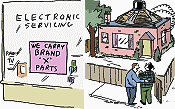 Here are a couple
high
tech comics for your enjoyment from the pages of the July 1961 edition of
Electronics World magazine. I'm guessing the joke in the page 72 comic
is that unknown parts were/are generically referred to as "Brand X," so hopefully
that would bring in customers who couldn't identify components (which the repairman
probably could). The page 94 comic is yet another play on the huge popularity
of home hi-fidelity (hi-fi) sound systems of the day. Amplifiers still used vacuum
tubes so building speaker driver circuits that could handle hundreds of watts was
easy to do. Finding speakers to handle that power (and getting neighbors to tolerate... Here are a couple
high
tech comics for your enjoyment from the pages of the July 1961 edition of
Electronics World magazine. I'm guessing the joke in the page 72 comic
is that unknown parts were/are generically referred to as "Brand X," so hopefully
that would bring in customers who couldn't identify components (which the repairman
probably could). The page 94 comic is yet another play on the huge popularity
of home hi-fidelity (hi-fi) sound systems of the day. Amplifiers still used vacuum
tubes so building speaker driver circuits that could handle hundreds of watts was
easy to do. Finding speakers to handle that power (and getting neighbors to tolerate...
 In case you are wondering, here is how you
would write "Merry Christmas and Happy New Year" in the world's most prominent languages.
While not everyone celebrates the birth of Jesus, most recognize the holiday spirit
during what we call the Christmas Season. This image includes the same hopeful and
grateful message to everyone. Thanks to all of you who has helped make RF Cafe
a success since 1999! In case you are wondering, here is how you
would write "Merry Christmas and Happy New Year" in the world's most prominent languages.
While not everyone celebrates the birth of Jesus, most recognize the holiday spirit
during what we call the Christmas Season. This image includes the same hopeful and
grateful message to everyone. Thanks to all of you who has helped make RF Cafe
a success since 1999!
 At the prompting of others, I decided to
give podcasting a try. Having been advised
that I have a face for radio and a voice for print, there was some hesitation on
my part. However, there have been many fine articles published in vintage electronics
magazine that people might be willing to listen to when there is no opportunity
or desire to read them. Regular features such as "Carl & Jerry," "Mac's Radio
Service Shop," editorials by the great Hugo Gernsback, and other types that do not
contain images which need to be referred to in order to get the gist of the content,
are prime targets for podcast listening. If the podcasts prove to be popular enough,
I will expand to a paid subscription... At the prompting of others, I decided to
give podcasting a try. Having been advised
that I have a face for radio and a voice for print, there was some hesitation on
my part. However, there have been many fine articles published in vintage electronics
magazine that people might be willing to listen to when there is no opportunity
or desire to read them. Regular features such as "Carl & Jerry," "Mac's Radio
Service Shop," editorials by the great Hugo Gernsback, and other types that do not
contain images which need to be referred to in order to get the gist of the content,
are prime targets for podcast listening. If the podcasts prove to be popular enough,
I will expand to a paid subscription...
 KR Electronics has been designing and manufacturing custom filters
for military and commercial radio, radar, medical, and communications since 1973.
KR Electronics' line of filters includes lowpass, highpass, bandpass, bandstop,
equalizer, duplexer, diplexer, and individually synthesized filters for special
applications - both commercial and military. State-of-the-art computer synthesis,
analysis, and test methods are used to meet the most challenging specifications.
All common connector types and package form factors are available. Update: KR Electronics
has been acquired by NIC, where KR Electronics'
legacy of quality and innovation will continue to thrive, offering the same trusted
products and services under NIC's leadership. For over three decades, NIC has delivered
high-quality component performance and reliability, ensuring the successful deployment
and operation of our clients' mission-critical solutions. Designed and manufactured
in the USA. Please visit NIC today to see how
we might be of assistance. KR Electronics has been designing and manufacturing custom filters
for military and commercial radio, radar, medical, and communications since 1973.
KR Electronics' line of filters includes lowpass, highpass, bandpass, bandstop,
equalizer, duplexer, diplexer, and individually synthesized filters for special
applications - both commercial and military. State-of-the-art computer synthesis,
analysis, and test methods are used to meet the most challenging specifications.
All common connector types and package form factors are available. Update: KR Electronics
has been acquired by NIC, where KR Electronics'
legacy of quality and innovation will continue to thrive, offering the same trusted
products and services under NIC's leadership. For over three decades, NIC has delivered
high-quality component performance and reliability, ensuring the successful deployment
and operation of our clients' mission-critical solutions. Designed and manufactured
in the USA. Please visit NIC today to see how
we might be of assistance.
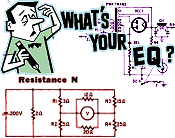 Another
triplet of electronics circuit challenges here for you from a 1962 issue of
Radio-Electronics magazine - a resistor network, a voltage divider, and
a delayed switching circuit. As is usually the case with the resistor network, rearranging
the circuit branches into a more familiar configuration simplifies its analysis.
That is a good general rule when analyzing any circuit - rearrange and break down
into recognizable subcircuits. The series circuit is about as simple as it gets,
but knowing about how an ammeter is constructed helps. The Delayed Switching challenge
is a little misleading in its description since the proposed solutions does use
a vacuum tube duo diode (aka dual diode or full-wave diode) as part of the power
supply circuit, although... Another
triplet of electronics circuit challenges here for you from a 1962 issue of
Radio-Electronics magazine - a resistor network, a voltage divider, and
a delayed switching circuit. As is usually the case with the resistor network, rearranging
the circuit branches into a more familiar configuration simplifies its analysis.
That is a good general rule when analyzing any circuit - rearrange and break down
into recognizable subcircuits. The series circuit is about as simple as it gets,
but knowing about how an ammeter is constructed helps. The Delayed Switching challenge
is a little misleading in its description since the proposed solutions does use
a vacuum tube duo diode (aka dual diode or full-wave diode) as part of the power
supply circuit, although...
 As our traditions are besieged by malcontents
determined to denigrate, impugn, and ultimately erase memories of holidays and events
that have meant so much to families and friends, I feel compelled to resist the
movement by documenting parts of the past that will cause us to wax nostalgic over
our cherished traditions. Intimidation and violence is part of the strategic calculus;
we have seen it in spades in 2020, and 2021 promises to be even worse. The Cancel
Culture might eventually win out with the complicity of government agents both elected
and unelected, but I'm not going down without a fight. Here is a collection of twentieth
century, December issue
QST magazine covers with Christmas themes that will no doubt be
familiar to many of you. Finding them was more difficult... As our traditions are besieged by malcontents
determined to denigrate, impugn, and ultimately erase memories of holidays and events
that have meant so much to families and friends, I feel compelled to resist the
movement by documenting parts of the past that will cause us to wax nostalgic over
our cherished traditions. Intimidation and violence is part of the strategic calculus;
we have seen it in spades in 2020, and 2021 promises to be even worse. The Cancel
Culture might eventually win out with the complicity of government agents both elected
and unelected, but I'm not going down without a fight. Here is a collection of twentieth
century, December issue
QST magazine covers with Christmas themes that will no doubt be
familiar to many of you. Finding them was more difficult...
 John T. Frye, born on March 14, 1910 and
passing on January 31, 1985, was a celebrated author, electronics enthusiast, and
technical writer whose work left an indelible mark on the world of radio and electronics.
According to historical records, he was stricken with polio as an infant, which
left him physically disabled and confined to a wheelchair. Despite this early adversity,
Frye demonstrated extraordinary perseverance and creativity, becoming one of the
most prolific and beloved contributors to technical literature during the mid-20th
century. John T. Frye's career as a writer began to flourish in the 1940s and 1950s,
when he penned numerous articles, instructional guides, and serialized stories that
combined entertainment with education. Among his most iconic works were the Carl &
Jerry stories, which ran for many years in Popular Electronics magazine... John T. Frye, born on March 14, 1910 and
passing on January 31, 1985, was a celebrated author, electronics enthusiast, and
technical writer whose work left an indelible mark on the world of radio and electronics.
According to historical records, he was stricken with polio as an infant, which
left him physically disabled and confined to a wheelchair. Despite this early adversity,
Frye demonstrated extraordinary perseverance and creativity, becoming one of the
most prolific and beloved contributors to technical literature during the mid-20th
century. John T. Frye's career as a writer began to flourish in the 1940s and 1950s,
when he penned numerous articles, instructional guides, and serialized stories that
combined entertainment with education. Among his most iconic works were the Carl &
Jerry stories, which ran for many years in Popular Electronics magazine...
 "Unknown drone activity forced one of the
U.S.'s most critical military installations to shut down for several hours late
Friday evening and Saturday morning, officials confirmed. The incident prompted
heightened security measures and temporarily
halted operations at Wright-Patterson Air Force Base in Ohio. Home to the 88th
Air Base Wing, Wright-Patterson is one of the largest and most strategically important
bases in the U.S., tasked with advanced research, intelligence, and operations.
Unauthorized drone activity in military airspace poses significant risks, from espionage
to safety hazards. In audio recordings by the Air Force Base air traffic control,
which were shared online, an operator can be heard saying they are diverting 'over
base' air traffic..." "Unknown drone activity forced one of the
U.S.'s most critical military installations to shut down for several hours late
Friday evening and Saturday morning, officials confirmed. The incident prompted
heightened security measures and temporarily
halted operations at Wright-Patterson Air Force Base in Ohio. Home to the 88th
Air Base Wing, Wright-Patterson is one of the largest and most strategically important
bases in the U.S., tasked with advanced research, intelligence, and operations.
Unauthorized drone activity in military airspace poses significant risks, from espionage
to safety hazards. In audio recordings by the Air Force Base air traffic control,
which were shared online, an operator can be heard saying they are diverting 'over
base' air traffic..."
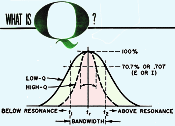 "Q" is an often used term to describe the
electrical "quality" of a circuit or component, and for the most part anyone
engaged in the conversation (verbally or via reading) understands the concept. However,
having a firm grasp on the technical ramifications is required if you happen to
be a circuit or system designer and need to conform to certain specifications. "Q"
can be good or bad, depending on your needs. If, for example, you need a narrowband
receiver to reject adjacent signals or you are designing a high stability and spectrally
clean oscillator, then you want all the "Q" you can get. On the other hand, if your
goal is to receive a spread spectrum signal or generate white noise across some
bandwidth, then a lower "Q" is what... "Q" is an often used term to describe the
electrical "quality" of a circuit or component, and for the most part anyone
engaged in the conversation (verbally or via reading) understands the concept. However,
having a firm grasp on the technical ramifications is required if you happen to
be a circuit or system designer and need to conform to certain specifications. "Q"
can be good or bad, depending on your needs. If, for example, you need a narrowband
receiver to reject adjacent signals or you are designing a high stability and spectrally
clean oscillator, then you want all the "Q" you can get. On the other hand, if your
goal is to receive a spread spectrum signal or generate white noise across some
bandwidth, then a lower "Q" is what...
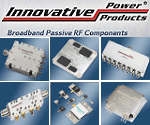 Innovative Power Products has been designing
and manufacturing RF and Microwave passive components since 2005. We use the latest
design tools available to build our baluns, 90-degree couplers, directional couplers,
combiners/dividers, single-ended transformers, resistors, terminations, and custom
products. Applications in military, medical, industrial, and commercial markets
are serviced around the world. Products listed on the website link to detailed mechanical
drawings, electrical specifications, and performance data. If you cannot find a
product that meets your requirements on our website, contact us to speak with one
of our experienced design engineers about your project. Innovative Power Products has been designing
and manufacturing RF and Microwave passive components since 2005. We use the latest
design tools available to build our baluns, 90-degree couplers, directional couplers,
combiners/dividers, single-ended transformers, resistors, terminations, and custom
products. Applications in military, medical, industrial, and commercial markets
are serviced around the world. Products listed on the website link to detailed mechanical
drawings, electrical specifications, and performance data. If you cannot find a
product that meets your requirements on our website, contact us to speak with one
of our experienced design engineers about your project.
|
 A lot of innovation went into perfecting
telegraph keys. The earliest keys were the familiar "straight
key" tapping type where the operator uses a single finger to close a set of contacts
that "keyed" the transmitter for a burst of RF energy. The length of each "dit"
or "dah" was determined by the operator's dwell time. It didn't take long for someone
to improve on the scheme by designing keys that assured an adjustable, constant
length for a dit or a dah. Poor quality transmitters with lousy rising and falling
edge signatures at the beginning and end, respectively, of a CW pulse made matters
worse. Constant length bursts make it easier for... A lot of innovation went into perfecting
telegraph keys. The earliest keys were the familiar "straight
key" tapping type where the operator uses a single finger to close a set of contacts
that "keyed" the transmitter for a burst of RF energy. The length of each "dit"
or "dah" was determined by the operator's dwell time. It didn't take long for someone
to improve on the scheme by designing keys that assured an adjustable, constant
length for a dit or a dah. Poor quality transmitters with lousy rising and falling
edge signatures at the beginning and end, respectively, of a CW pulse made matters
worse. Constant length bursts make it easier for...
 This assortment of custom-designed themes
by RF Cafe includes T-Shirts, Mouse Pads, Clocks, Tote Bags, Coffee Mugs and Steins,
Purses, Sweatshirts, Baseball Caps, and more, all sporting my amazingly clever "RF Engineers - We Are the World's Matchmakers"
Smith chart design. These would make excellent gifts for husbands, wives, kids,
significant others, and for handing out at company events or as rewards for excellent
service. My graphic has been ripped off by other people and used on their products,
so please be sure to purchase only official RF Cafe gear. I only make a couple bucks
on each sale - the rest goes to Cafe Press. It's a great way to help support RF
Cafe. Thanks... This assortment of custom-designed themes
by RF Cafe includes T-Shirts, Mouse Pads, Clocks, Tote Bags, Coffee Mugs and Steins,
Purses, Sweatshirts, Baseball Caps, and more, all sporting my amazingly clever "RF Engineers - We Are the World's Matchmakers"
Smith chart design. These would make excellent gifts for husbands, wives, kids,
significant others, and for handing out at company events or as rewards for excellent
service. My graphic has been ripped off by other people and used on their products,
so please be sure to purchase only official RF Cafe gear. I only make a couple bucks
on each sale - the rest goes to Cafe Press. It's a great way to help support RF
Cafe. Thanks...
 Banner Ads are rotated in all locations
on the page! RF Cafe typically receives 8,000-15,000 visits each
weekday. RF Cafe
is a favorite of engineers, technicians, hobbyists, and students all over the world.
With more than 17,000 pages in the Google search index, RF Cafe returns in
favorable positions on many types of key searches, both for text and images.
Your Banner Ads are displayed on average 225,000 times per year! New content
is added on a daily basis, which keeps the major search engines interested enough
to spider it multiple times each day. Items added on the homepage often can be found
in a Google search within a few hours of being posted. If you need your company
news to be seen, RF Cafe is the place to be... Banner Ads are rotated in all locations
on the page! RF Cafe typically receives 8,000-15,000 visits each
weekday. RF Cafe
is a favorite of engineers, technicians, hobbyists, and students all over the world.
With more than 17,000 pages in the Google search index, RF Cafe returns in
favorable positions on many types of key searches, both for text and images.
Your Banner Ads are displayed on average 225,000 times per year! New content
is added on a daily basis, which keeps the major search engines interested enough
to spider it multiple times each day. Items added on the homepage often can be found
in a Google search within a few hours of being posted. If you need your company
news to be seen, RF Cafe is the place to be...
 In 1931, QST reader John H. Miller, Electrical
Engineer, of the Jewell Electrical Instrument Company, wrote to the editor regarding
the story "What Is This Thing Called Decibel?," by James L McLaughlin and James
J. Lamb, which appeared in the August issue of that year. Mr. Miller wished to inform
(or remind) readers that the
American Wire Gauge
system for assigning sizes to wire cross-section ratios closely follows a decibel
(i.e., logarithmic) relationship. Applying his information: A 28 AWG solid wire
has a cross-section of 160 circular mils, so at 3 sizes larger, 25 AWG should be
320 circular mils. In fact, it is 320 circular mils. A 12 AWG solid wire has a cross-section
of 5,630 circular mils, so at 3 sizes larger, 9 AWG should be 13,060 circular mils,
and it is 13,090 circular mils. That verifies the 3 dB per three differences
in gauge for two cases using small and large wire sizes. What about, say, 5 dB
for 5 wires sizes in difference? Using 28 AWG again as a reference, a 5 dB
increase in size for 28-5=23 AWG wire should be about... In 1931, QST reader John H. Miller, Electrical
Engineer, of the Jewell Electrical Instrument Company, wrote to the editor regarding
the story "What Is This Thing Called Decibel?," by James L McLaughlin and James
J. Lamb, which appeared in the August issue of that year. Mr. Miller wished to inform
(or remind) readers that the
American Wire Gauge
system for assigning sizes to wire cross-section ratios closely follows a decibel
(i.e., logarithmic) relationship. Applying his information: A 28 AWG solid wire
has a cross-section of 160 circular mils, so at 3 sizes larger, 25 AWG should be
320 circular mils. In fact, it is 320 circular mils. A 12 AWG solid wire has a cross-section
of 5,630 circular mils, so at 3 sizes larger, 9 AWG should be 13,060 circular mils,
and it is 13,090 circular mils. That verifies the 3 dB per three differences
in gauge for two cases using small and large wire sizes. What about, say, 5 dB
for 5 wires sizes in difference? Using 28 AWG again as a reference, a 5 dB
increase in size for 28-5=23 AWG wire should be about...
 Credit for being the first to accomplish any notable
feat, whether in sports, medicine, science, aviation, etc., is constantly being challenged.
Some contestations are worthy of consideration based on documented facts, while others
can be readily dismissed as crockery. Gustave Whitehead, per anti-Wright Brothers zealots,
made the first powered airplane flight. The Vikings landed in America centuries prior
to Columbus - supposedly. Many stories have been written claiming that Dr. Mahlon Loomis,
a dentist, beat Guglielmo Marconi in the wireless communications race by using a system
of kites that took on a charge from overhead clouds. A keying device opened and closed
a conductive path to ground for effecting the Morse code... Credit for being the first to accomplish any notable
feat, whether in sports, medicine, science, aviation, etc., is constantly being challenged.
Some contestations are worthy of consideration based on documented facts, while others
can be readily dismissed as crockery. Gustave Whitehead, per anti-Wright Brothers zealots,
made the first powered airplane flight. The Vikings landed in America centuries prior
to Columbus - supposedly. Many stories have been written claiming that Dr. Mahlon Loomis,
a dentist, beat Guglielmo Marconi in the wireless communications race by using a system
of kites that took on a charge from overhead clouds. A keying device opened and closed
a conductive path to ground for effecting the Morse code...
 With more than 1000
custom-built stencils, this has got to be the most comprehensive set of
Visio Stencils
available for RF, analog, and digital system and schematic drawings! Every stencil
symbol has been built to fit proportionally on the included A-, B-, and C-size drawing
page templates (or use your own page if preferred). Components are provided for
system block diagrams, conceptual drawings, schematics, test equipment, racks, and
more. Page templates are provided with a preset scale (changeable) for a good presentation
that can incorporate all provided symbols... With more than 1000
custom-built stencils, this has got to be the most comprehensive set of
Visio Stencils
available for RF, analog, and digital system and schematic drawings! Every stencil
symbol has been built to fit proportionally on the included A-, B-, and C-size drawing
page templates (or use your own page if preferred). Components are provided for
system block diagrams, conceptual drawings, schematics, test equipment, racks, and
more. Page templates are provided with a preset scale (changeable) for a good presentation
that can incorporate all provided symbols...
 Here is a short tutorial on how to construct
a
¼-wave stub "trap," or filter to attenuate even-order harmonics from transmission
lines. It applies whether the transmission line is feeding an antenna or is a section
of copper foil running on a microwave substrate. Author Kent Mitchell (W3WTO) discusses
both an open stub and a shorted stub. In case you are not familiar with how quarter-wave
transmission lines stub work, a short at the far end appears as an open circuit
where the stub connects to the main transmission line, and an open stub line appears
as a short circuit. That is because there is a 180° phase shift at the end of the
shorted stub and a 0° phase shift at the end of the open stub. Therefore, there
is a total of 360° (i.e., 90°+180°+90°=360°, equivalent to 0°) with the shorted
¼-wave stub so it has no effect where it attaches to the main transmission line.
The open stub experiences no phase shift... Here is a short tutorial on how to construct
a
¼-wave stub "trap," or filter to attenuate even-order harmonics from transmission
lines. It applies whether the transmission line is feeding an antenna or is a section
of copper foil running on a microwave substrate. Author Kent Mitchell (W3WTO) discusses
both an open stub and a shorted stub. In case you are not familiar with how quarter-wave
transmission lines stub work, a short at the far end appears as an open circuit
where the stub connects to the main transmission line, and an open stub line appears
as a short circuit. That is because there is a 180° phase shift at the end of the
shorted stub and a 0° phase shift at the end of the open stub. Therefore, there
is a total of 360° (i.e., 90°+180°+90°=360°, equivalent to 0°) with the shorted
¼-wave stub so it has no effect where it attaches to the main transmission line.
The open stub experiences no phase shift...
 Honestly, I don't remember why I scanned
this advertisement for
Sarkes Tarzian recorder tape that appeared in a 1962 edition of Popular Electronics
magazine. Maybe it was to illustrate how far personal recording technology has come
in the half century since the ad ran. Today's recorders are in the form of a very
small digital device the size of a pack of gum (or any smartphone can be used),
and not only is the miniature recorder capable of storing longer sessions, but the
quality of the recording is almost certainly better. The cost of a digital recorder
is about the same in inflated dollars as a spool of tape was in 1962... Honestly, I don't remember why I scanned
this advertisement for
Sarkes Tarzian recorder tape that appeared in a 1962 edition of Popular Electronics
magazine. Maybe it was to illustrate how far personal recording technology has come
in the half century since the ad ran. Today's recorders are in the form of a very
small digital device the size of a pack of gum (or any smartphone can be used),
and not only is the miniature recorder capable of storing longer sessions, but the
quality of the recording is almost certainly better. The cost of a digital recorder
is about the same in inflated dollars as a spool of tape was in 1962...
 Here are a couple more
electronics-themed comics from the March 1967 issue of Popular Electronics
magazine for your TGIF enjoyment. The comic on page 100 especially appeals to me since
I am finishing the installation of a Channel Master CM-5020 antenna. It has been a long
time since I installed a traditional style TV antenna - about 40 years ago when I put
a Radio Shack antenna on the roof of my mother's house. The entire 109" long by 100"
wide antenna, including mounting hardware, weighs only 11.5 pounds and presents
a wind resistance of 30 pounds. This is Channel Master's best antenna... Here are a couple more
electronics-themed comics from the March 1967 issue of Popular Electronics
magazine for your TGIF enjoyment. The comic on page 100 especially appeals to me since
I am finishing the installation of a Channel Master CM-5020 antenna. It has been a long
time since I installed a traditional style TV antenna - about 40 years ago when I put
a Radio Shack antenna on the roof of my mother's house. The entire 109" long by 100"
wide antenna, including mounting hardware, weighs only 11.5 pounds and presents
a wind resistance of 30 pounds. This is Channel Master's best antenna...
 RF Cafe visitor Cris Schulze saw the Design
News article I linked to titled, "EMI Emissions Testing: Peak, Quasi-Peak, and Average Measurements,"
and has given permission to reprint his brief response to it (originally posted
on LinkedIn). The included notebook image includes an excerpt from Wikipedia's quasi-peak
detector page, and he illustrates a block diagram of the test chain with de Forest's
audion circuit that provides the fast rise-time and slow fall-time that characterizes
it. A table of actual test data compares quasi-peak measurements to average measurements... RF Cafe visitor Cris Schulze saw the Design
News article I linked to titled, "EMI Emissions Testing: Peak, Quasi-Peak, and Average Measurements,"
and has given permission to reprint his brief response to it (originally posted
on LinkedIn). The included notebook image includes an excerpt from Wikipedia's quasi-peak
detector page, and he illustrates a block diagram of the test chain with de Forest's
audion circuit that provides the fast rise-time and slow fall-time that characterizes
it. A table of actual test data compares quasi-peak measurements to average measurements...
 Prior to the availability of high speed semiconductor
circuitry, there was not enough computational power available - particularly in
airborne platforms - to perform a significant amount of real-time signal processing
in
radar systems. Analog methods were available to do things like
stationary target cancellation (moving target indication, MTI) and noise reduction
to eliminate clutter on the plan position indicator (PPI, aka radar scope), range
and azimuth blanking of selected regions of the scan, signal discriminators and
integrators, and false target elimination via pulse repetition rate (PRR) and pulse
repetition interval (PRI). There was nothing, really, in the older vacuum tube based
systems to derive a target profile based on radar cross section (RCS) and signal
vector (amplitude and phase) processing. This 1971 article reported on what was
at the time information about very new technology that was just being... Prior to the availability of high speed semiconductor
circuitry, there was not enough computational power available - particularly in
airborne platforms - to perform a significant amount of real-time signal processing
in
radar systems. Analog methods were available to do things like
stationary target cancellation (moving target indication, MTI) and noise reduction
to eliminate clutter on the plan position indicator (PPI, aka radar scope), range
and azimuth blanking of selected regions of the scan, signal discriminators and
integrators, and false target elimination via pulse repetition rate (PRR) and pulse
repetition interval (PRI). There was nothing, really, in the older vacuum tube based
systems to derive a target profile based on radar cross section (RCS) and signal
vector (amplitude and phase) processing. This 1971 article reported on what was
at the time information about very new technology that was just being...
 1965 was the beginning of America's involvement
in Vietnam. A mere decade had passed since the end of the Korean War (or "conflict" if
you prefer), and the Department of Defense had not done much to modernize the military
since then. Unlike with World War II when U.S. factories were turning out military
aircraft, ships, and ground vehicles ahead of formal involvement, Congress was not interested
in making headlines with news of war machines. The "Washington
Newsletter" feature of this October 1965 issue of Electronics magazine reported
on, among other military-related items, the U.S. Air Force's plans to phase out the venerated
B-52 Stratofortress bomber by sometime in the 1970s. Here it is half a century
later and the B-52... 1965 was the beginning of America's involvement
in Vietnam. A mere decade had passed since the end of the Korean War (or "conflict" if
you prefer), and the Department of Defense had not done much to modernize the military
since then. Unlike with World War II when U.S. factories were turning out military
aircraft, ships, and ground vehicles ahead of formal involvement, Congress was not interested
in making headlines with news of war machines. The "Washington
Newsletter" feature of this October 1965 issue of Electronics magazine reported
on, among other military-related items, the U.S. Air Force's plans to phase out the venerated
B-52 Stratofortress bomber by sometime in the 1970s. Here it is half a century
later and the B-52...
 This is part 4 of the "All About IC's" series that
appeared in Radio-Electronics magazine in 1969, where author Bob Hibberd
discusses the various types of integrate circuit (IC) families. He is not
referring to TTL and CMOS with divisions into small scale integration (SSI),
medium scale integration (MSI), large scale integration (LSI), and very large
scale integration (VLSI) like we have today. Back in 1969 the IC world was still
evolving through basic circuit structures like diode-diode logic (DDL),
diode-transistor logic (DTL), resistor-transistor logic (RTL), direct-coupled
transistor logic (DCTL), etc. What seems obvious now needed to be learned and
dealt with then. It is like struggling with a homework problem and being able to
look at the answer worked out in the back of the book where the solution then
looks obvious... This is part 4 of the "All About IC's" series that
appeared in Radio-Electronics magazine in 1969, where author Bob Hibberd
discusses the various types of integrate circuit (IC) families. He is not
referring to TTL and CMOS with divisions into small scale integration (SSI),
medium scale integration (MSI), large scale integration (LSI), and very large
scale integration (VLSI) like we have today. Back in 1969 the IC world was still
evolving through basic circuit structures like diode-diode logic (DDL),
diode-transistor logic (DTL), resistor-transistor logic (RTL), direct-coupled
transistor logic (DCTL), etc. What seems obvious now needed to be learned and
dealt with then. It is like struggling with a homework problem and being able to
look at the answer worked out in the back of the book where the solution then
looks obvious...
 You're not going to find much information
about the "Futuramic
Antenna" by doing an Internet search. I had never head of such an antenna before
seeing this article about it in the October 1952 issue of Radio-Electronics magazine.
Although it was the trade name of a design by Channel Master, the authors (company
engineers) claim it is a variation of a Yagi antenna which provides a much wider
bandwidth by stacking multiple antennas and phase adjusting them in a combiner.
The story takes place in the era shortly after the FCC ended a freeze on new television
broadcast station licenses (1948) because channel assignments in the spectrum were
being changed and UHF channels added, rendering some older equipment in need of
modification or replacement. The effort was a model of bureaucratic chaos... You're not going to find much information
about the "Futuramic
Antenna" by doing an Internet search. I had never head of such an antenna before
seeing this article about it in the October 1952 issue of Radio-Electronics magazine.
Although it was the trade name of a design by Channel Master, the authors (company
engineers) claim it is a variation of a Yagi antenna which provides a much wider
bandwidth by stacking multiple antennas and phase adjusting them in a combiner.
The story takes place in the era shortly after the FCC ended a freeze on new television
broadcast station licenses (1948) because channel assignments in the spectrum were
being changed and UHF channels added, rendering some older equipment in need of
modification or replacement. The effort was a model of bureaucratic chaos...
 In this saga of YL (young lady) and OM (old man)
Ham radio operators, General license holder
Carole H. Allen elucidates, with a touch of humor, the woes beset upon women
pertaining to repairing radio equipment. Mrs. Allen's lament is in fact not the
treatment of women participating in the communication aspect of Ham radio, but
the reluctance of men to allow them to engage in the technical aspects of the
electronic equipment. From an operator standpoint, guessing the gender of the
Ham on the other end of the signal can be nearly impossible, particularly with
CW (Morse code). Poor transmission quality can make phone (voice) determination
of YL or OM difficult sometimes as well. Back in the 1960s it was not possible
to simply surf to the FCC's Universal License System website... In this saga of YL (young lady) and OM (old man)
Ham radio operators, General license holder
Carole H. Allen elucidates, with a touch of humor, the woes beset upon women
pertaining to repairing radio equipment. Mrs. Allen's lament is in fact not the
treatment of women participating in the communication aspect of Ham radio, but
the reluctance of men to allow them to engage in the technical aspects of the
electronic equipment. From an operator standpoint, guessing the gender of the
Ham on the other end of the signal can be nearly impossible, particularly with
CW (Morse code). Poor transmission quality can make phone (voice) determination
of YL or OM difficult sometimes as well. Back in the 1960s it was not possible
to simply surf to the FCC's Universal License System website...
 Phase noise measurements quantify the short term
stability of a frequency source. That is because phase and frequency are mathematically
related by a differential function [ω(t) = dΦ(t)/dt] so they are directly
connected. Phase noise also includes amplitude instability due to atomic scale
effects like FM flicker noise (1/f3), white noise (1/f2), PM flicker
noise (1/f), and possibly even voltage supply noise (typically discrete spurs).
When the frequency source is used as a local oscillator in a frequency converter
(up- or down-), the amount of instability (jitter) is modulated onto the
transmitter or received signal. While not usually a major concern in analog
systems, in high speed digital communication systems phase noise can degrade the
ability of the receiver to correctly determine the difference between a "1" and
a"0." That is because... Phase noise measurements quantify the short term
stability of a frequency source. That is because phase and frequency are mathematically
related by a differential function [ω(t) = dΦ(t)/dt] so they are directly
connected. Phase noise also includes amplitude instability due to atomic scale
effects like FM flicker noise (1/f3), white noise (1/f2), PM flicker
noise (1/f), and possibly even voltage supply noise (typically discrete spurs).
When the frequency source is used as a local oscillator in a frequency converter
(up- or down-), the amount of instability (jitter) is modulated onto the
transmitter or received signal. While not usually a major concern in analog
systems, in high speed digital communication systems phase noise can degrade the
ability of the receiver to correctly determine the difference between a "1" and
a"0." That is because...
 Diode characteristics and their applications
have not changed fundamentally since this article was published in 1952. Sure, the
die are smaller, power handling and frequency range has increased, package styles
are greatly expanded, and the cost per unit is way down, but if you are looking
for some basic diode information, you will find it here in this 4th installment
of a multi-part series in Radio & Television News magazine. Don't
let the vacuum tubes in schematics scare you off and think that it makes the
story irrelevant for today's circuits. For purposes of illustration substitute a
transistor's collector (or drain) for the tube's plate, a transistor's base (or
gate) for the tube's screen grid, and a transistor's emitter (or source) for the
tube's cathode... Diode characteristics and their applications
have not changed fundamentally since this article was published in 1952. Sure, the
die are smaller, power handling and frequency range has increased, package styles
are greatly expanded, and the cost per unit is way down, but if you are looking
for some basic diode information, you will find it here in this 4th installment
of a multi-part series in Radio & Television News magazine. Don't
let the vacuum tubes in schematics scare you off and think that it makes the
story irrelevant for today's circuits. For purposes of illustration substitute a
transistor's collector (or drain) for the tube's plate, a transistor's base (or
gate) for the tube's screen grid, and a transistor's emitter (or source) for the
tube's cathode...
 "Plug-Ugly
Eliminator" could refer to a couple possible devices. One might be some sort
of cover for hiding electrical cords and plugs where the go into a wall socket.
It might also be a move decorative type plug than the standard kind on the end of
a line cord. What the Plug-Ugly Eliminator actually is, is an overly complex contraption
allowing a radio listener to turn off a radio for a predetermined amount of time
when "commercial announcements in which he may have no interest or which may even
be offensive to him" begins playing. The "Plug" part of the name is another name
for a commercial. Maurice Kay's Plug-Ugly Eliminator, which appeared in the May
1946 issue of Radio-Craft magazine, is another items where if had occurred
in an April edition, you might think you were being pranked for April Fools. The
drawing certainly has the characteristics of a Rube Goldberg creation... "Plug-Ugly
Eliminator" could refer to a couple possible devices. One might be some sort
of cover for hiding electrical cords and plugs where the go into a wall socket.
It might also be a move decorative type plug than the standard kind on the end of
a line cord. What the Plug-Ugly Eliminator actually is, is an overly complex contraption
allowing a radio listener to turn off a radio for a predetermined amount of time
when "commercial announcements in which he may have no interest or which may even
be offensive to him" begins playing. The "Plug" part of the name is another name
for a commercial. Maurice Kay's Plug-Ugly Eliminator, which appeared in the May
1946 issue of Radio-Craft magazine, is another items where if had occurred
in an April edition, you might think you were being pranked for April Fools. The
drawing certainly has the characteristics of a Rube Goldberg creation...
 Someone sent me a link to a viral video of a group
of teenagers (aka "Millennials") attempting to use an old school dial type telephone.
Two things are notable. #1: They do not remove the handset from the cradle prior to dialing.
#2: One of them asks whether it is necessary to let the dial spin all the way back to
rest before dialing the next number. It's really not their fault since except for in
dusty old places like my house, finding a dial phone is difficult. Many historians have
commented that two innovations most responsible for America's greatness in the last century
were the interstate highway system (for moving goods) and the telephone system. Bell
Telephone Labs engineers designed phones and all the equipment that connected them to
be simple, highly functional, robust, and to have... Someone sent me a link to a viral video of a group
of teenagers (aka "Millennials") attempting to use an old school dial type telephone.
Two things are notable. #1: They do not remove the handset from the cradle prior to dialing.
#2: One of them asks whether it is necessary to let the dial spin all the way back to
rest before dialing the next number. It's really not their fault since except for in
dusty old places like my house, finding a dial phone is difficult. Many historians have
commented that two innovations most responsible for America's greatness in the last century
were the interstate highway system (for moving goods) and the telephone system. Bell
Telephone Labs engineers designed phones and all the equipment that connected them to
be simple, highly functional, robust, and to have...
 At least 10 clues with an asterisk (*)
in this
technology-themed crossword puzzle are pulled from this past week's (5/21
- 5/25) "Tech Industry Headlines" column on the RF Cafe homepage. For the sake
of all the avid cruciverbalists amongst us, each week I create a new
technology-themed crossword puzzle using only words from my custom-created
related to engineering, science, mathematics, chemistry, physics, astronomy,
etc. You will never find among the words names of politicians, mountain ranges,
exotic foods or plants, movie stars, or anything of the sort. You might,
however, see someone or something in the exclusion list who or that is directly
related to this puzzle's theme, such as Hedy Lamar... At least 10 clues with an asterisk (*)
in this
technology-themed crossword puzzle are pulled from this past week's (5/21
- 5/25) "Tech Industry Headlines" column on the RF Cafe homepage. For the sake
of all the avid cruciverbalists amongst us, each week I create a new
technology-themed crossword puzzle using only words from my custom-created
related to engineering, science, mathematics, chemistry, physics, astronomy,
etc. You will never find among the words names of politicians, mountain ranges,
exotic foods or plants, movie stars, or anything of the sort. You might,
however, see someone or something in the exclusion list who or that is directly
related to this puzzle's theme, such as Hedy Lamar...
 A decade after
tunnel diodes were first invented by Nobel Laureate Leo Esaki, grand plans for the
unique device never played out. Predictions included its use for computer solid state
memories to replace magnetic core arrays. Tunnel diodes benefitted from the aura surrounding
their exploitation of the quantum mechanical tunnelling phenomenon, which had a futuristic
ring to it. Conventional diodes, having a relatively wide depletion region, require the
current carriers (electrons and holes) to overcome a potential hill in traveling from
the valence band to the conduction band of energies. Since high doping levels are used
in the tunnel diode, a narrow depletion region is formed at the junction. This allows
electrons... A decade after
tunnel diodes were first invented by Nobel Laureate Leo Esaki, grand plans for the
unique device never played out. Predictions included its use for computer solid state
memories to replace magnetic core arrays. Tunnel diodes benefitted from the aura surrounding
their exploitation of the quantum mechanical tunnelling phenomenon, which had a futuristic
ring to it. Conventional diodes, having a relatively wide depletion region, require the
current carriers (electrons and holes) to overcome a potential hill in traveling from
the valence band to the conduction band of energies. Since high doping levels are used
in the tunnel diode, a narrow depletion region is formed at the junction. This allows
electrons...
 Sometimes finding an existing instance of
one of the vintage radios is difficult or impossible. The
RCA Victor Model 54Bx portables are an exception. Plenty can be found for purchase
on eBay as this is written, as was a 54B1, 54B3, and a 54B4. I did a capture of
some of the listing images for a Model 54B2, and had Archive.org story a copy for
once the eBay site deletes it. In the internal photos, all four miniature vacuum
tubes (3S4, 1S5, 1R5, 1T4) can be clearly seen. Note also in the photos you can
see where, per the alignment procedure, rubber bands have been place around the
tubes in order to keep them from moving. The extremely cramped space required particular
attention to the routing of interconnect wires... Sometimes finding an existing instance of
one of the vintage radios is difficult or impossible. The
RCA Victor Model 54Bx portables are an exception. Plenty can be found for purchase
on eBay as this is written, as was a 54B1, 54B3, and a 54B4. I did a capture of
some of the listing images for a Model 54B2, and had Archive.org story a copy for
once the eBay site deletes it. In the internal photos, all four miniature vacuum
tubes (3S4, 1S5, 1R5, 1T4) can be clearly seen. Note also in the photos you can
see where, per the alignment procedure, rubber bands have been place around the
tubes in order to keep them from moving. The extremely cramped space required particular
attention to the routing of interconnect wires... |




































 Side-looking airborne radar (SLAR)
Side-looking airborne radar (SLAR)







 John T. Frye
John T. Frye

 Innovative Power Products
Innovative Power Products














 Phase noise
Phase noise Diode characteristics
Diode characteristics




